10TH MATH PROBLEMS FOR PRACTICE
Subscribe to our ▶️ YouTube channel 🔴 for the latest videos, updates, and tips.
Problem 1 :
Triangle KLM, shown on this coordinate plane, will be dilated by a scale factor of 1/2 with respect to the origin.
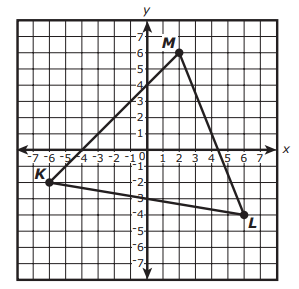
What are the ordered pairs that represent the vertices of the image of triangle KLM after the dilation?
Select the three ordered pairs.
A) (−3, −1) B) (−2, 3) C) (−1, −3) D) (1, 3)
E) (2, −2) F) (3, −2)
Solution :
The vertices of the triangle is K (-6, -2), M (2, 6) and L (6, -4).
Dilation with the scale factor of 1/2.
|
K (-6, -2) M (2, 6) L (6, -4) |
K' (-6/2, -2/2) ==>K' (-3, -1) M' (2/2, 6/2) ==>M' (1, 3) L' (6/2, -4/2) ==> L' (3, -2) |
So, option A, D and F are correct.
Problem 2 :
This question has two parts.
Part A :
Which of the following statements is true?
A The sum of two rational numbers is rational.
B The product of two rational numbers is irrational.
C The sum of a rational number and an irrational number is rational.
D The product of a non-zero rational number and an irrational number is rational.
Part B :
Which of the following statements is true?
A The sum of π/2 and π/2 is rational, and the product of 1/2 and π is rational.
B The sum of π/2 and π/2 is rational, and the product of 1/2 and π is irrational.
C The sum of π/2 and π/2 is irrational, and the product of 1/2 and π is rational.
D The sum of π/2 and π/2 is irrational, and the product of 1/2 and π is irrational
Solution :
Part A :
The sum of two rational numbers is rational.
For example,
2 and 3. Finding sum of 2 and 3, we get 5 which is rational number. So, option A is correct.
Part B :
The number which can be written in the form of p/q is known as rational number.
Sum of π/2 and π/2 = π/2 + π/2
= 2π/2
= π
= 22/7 (rational)
product of 1/2 and π = 1/2 x π
= π/2
= (22/7)/2
= 11/7 (rational)
So, option A is correct.
Problem 3 :
Which of the following is the solution set of this inequality?
2 − 4y > 14
A) y > −3 B) y < −3 C) y > 3 D) y < 3
Solution :
2 − 4y > 14
Subtracting 2 on both sides
-4y > 14 - 2
-4y > 12
Dividing by -4 on both sides, we get
y < -3
Problem 4 :
A right triangle and some of its measurements are shown in this diagram.
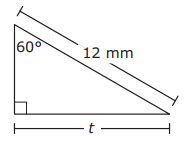
Based on the measurements shown in the diagram, what is t?
A) 6 mm B) 4√3 mm C) 6√3 mm D) 8 mm
Solution :
Using the trigonometry ratio sin θ
= Opposite side / Hypotenuse
sin θ = t/12
sin 60 = t/12
√3/2 = t/12
t = (√3/2) x 12
t = 6√3 mm
So, the answer is option C.
Problem 5 :
This diagram shows a right square pyramid and some of its dimensions.
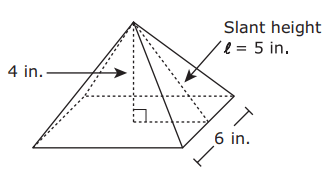
What is the volume of the pyramid?
A) 48 cubic inches B) 60 cubic inches
C) 144 cubic inches D) 180 cubic inches
Solution :
Volume of pyramid = (1/3) x base area x height
= (1/3) x area of square x 4
= (1/3) x 36 x 4
= 48 cubic inches
Problem 6 :
A travel agent surveyed people in two age groups about whether or not they like traveling. Which two-way table shows the possible results of the survey?
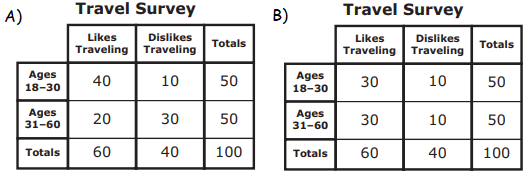
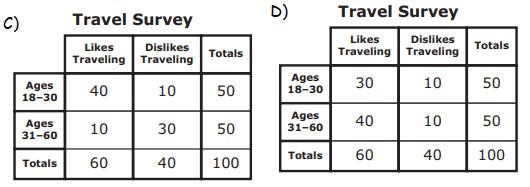
Solution :
Option A is correct.
Problem 7 :
Which of the following graphs does not represent y as a function of x?
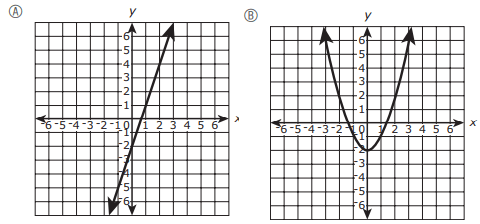
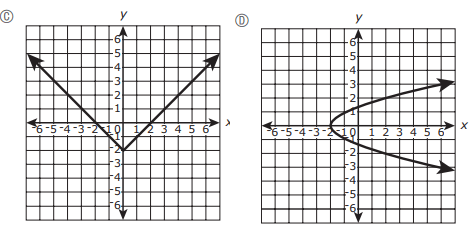
Solution :
Using a vertical line test, we can check whether the given graph is a function or not.
What is vertical line test ?
The vertical line should intersect the graph maximum at one point. If the vertical line which is intersecting the graph more than one point, then it will not be a function.
So, option D is not a function.
Problem 8 :
Consider square EFGH, shown on this coordinate plane
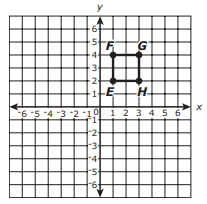
Square EFGH will be reflected over the y-axis. Which graph correctly shows the image of square EFGH after the reflection?
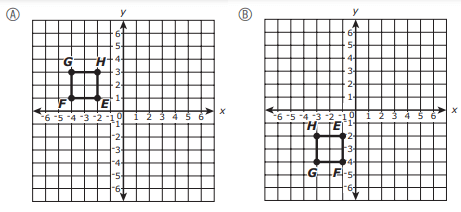
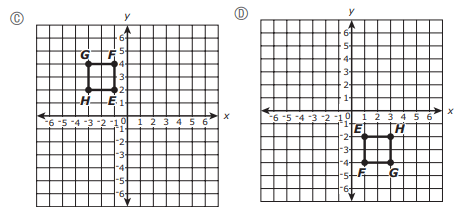
Solution :
The vertices of the given square is
E (1, 2), F(1, 4), G (3, 4) H(3, 2)
Since it is reflected over y-axis, we have to follow the rule, put x = -x.
E' (-1, 2), F' (-1, 4), G' (-3, 4) H' (-3, 2)
These are the vertices in the reflected figure A. So, option A is correct.
Problem 9 :
A parallelogram is shown on this coordinate plane.
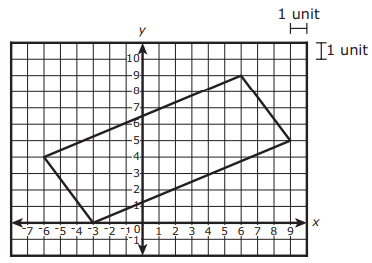
What is the perimeter, in units, of the parallelogram?
A) 24 B) 36 C) 48 D) 64
Solution :
Perimeter of parallelogram = sum of length of all sides
Distance between the points (-3, 0) and (9, 5)
Distance between the points (-3, 0) and (-6, 4)
Perimeter of the parallelogram = 2(13 + 5)
= 2 (18)
= 36 units.
Problem 10 :
A sphere and one of its dimensions are shown in this diagram.

Which of the following is closest to the volume of the sphere?
A) 9203 in3 B) 1150 in3 C) 163 in3 D) 82 in3
Solution :
Volume of sphere = (1/3) (4πr2) x r
= (4/3) (πr3)
= (4/3) x 3.14 x (6.5)3
= 1150 in3
Subscribe to our ▶️ YouTube channel 🔴 for the latest videos, updates, and tips.
Recent Articles
-
Finding Range of Values Inequality Problems
May 21, 24 08:51 PM
Finding Range of Values Inequality Problems -
Solving Two Step Inequality Word Problems
May 21, 24 08:51 AM
Solving Two Step Inequality Word Problems -
Exponential Function Context and Data Modeling
May 20, 24 10:45 PM
Exponential Function Context and Data Modeling